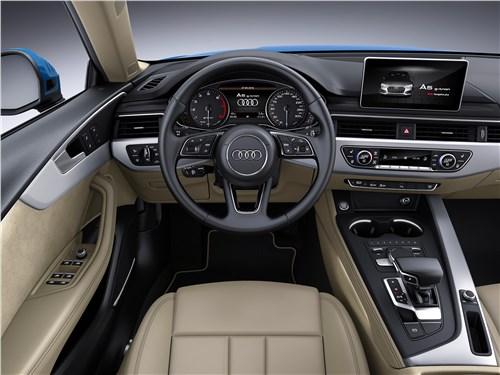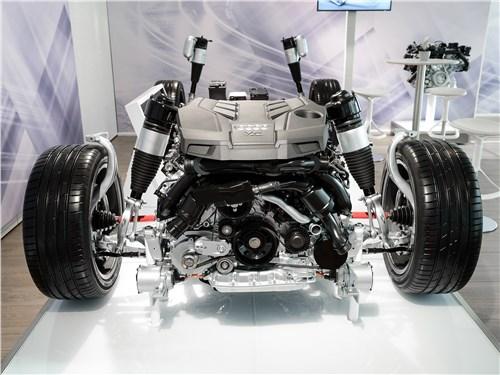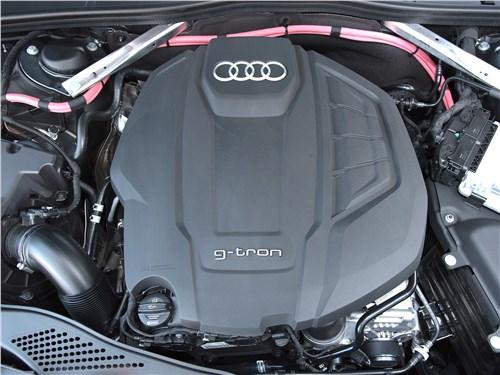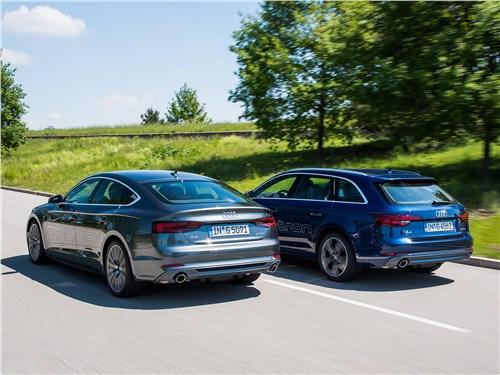Car device: stay in the future
The G-tron interior is no different from the standard Audi A4 and A5 models
In the new generation Audi A8, the engine is equipped with a belt starter-alternator
Audi is one of the world leaders in innovation in the automotive industry. To find out about the latest developments of this brand, we took part in a technical seminar in Germany, where I managed to understand that the cars in the world will drive very soon
The day allotted for this seminar turned out to be very full. Firstly, I got acquainted with the new power units that are already used in Audi cars, or start installing them in the very near future. Then we tested the universal A4 on natural gas and finally evaluated the new hybrid mild hybrid (mild hybrid), which is equipped with the latest generation A8 executive sedan.
Gasoline, diesel…
The Ingolstadt-based company has been producing V-shaped powertrains since 1988, when it debuted the 3.6-liter 8-cylinder engine in the Audi B8. A few years later, the world saw a 2.8-liter "six" for the Audi 100, and in 1990, engineers had already built the world’s first 2.5-liter 6-cylinder turbodiesel, adding more and more 3.3-liter 8-cylinder diesel engine. Later, in the beginning, there was a 2.7-liter twin-turbo V6 for the Audi RS 4 Avant, developing an unrealistic 380 hp in that time. with., which set new standards in the segment of mid-size cars.
Now the successor to this 2.7-liter unit has become a 2.9-liter twin-turbo V6. It produces 450 "horses" and is installed in the Audi 5 coupe. This engine is developed on the basis of a 3-liter turbo – "six" issuing 354 hp. with. and is located under the hood of many models with the S index, including the new generation of the A8 executive sedan.
The new Audi A8 engine is integrated into the hybrid system, and is also equipped with a starter-alternator belt, thanks to which starting and stopping is virtually vibration-free. In addition, they are ready to equip the engine with an electric compressor, which, by the way, is already used for a 4-liter 8-cylinder turbo engine installed on the Audi SQ7 crossover. The electric compressor solves the main problem of raised units called turbojam. The fact that a conventional turbine is spun by exhaust gases and therefore at low speeds, then electrotermia all around from 48-volt batteries and, accordingly, blowing really "from below". It should be said that Audi was the first to use an electric compressor on production cars.
Another new engine is a 4-liter V8 developed by engineers at Porsche. It was built on the basis of the V8 from the same Audi, introduced in 2012, but significantly redesigned. So, turbochargers are installed in the collapse of the cylinder block, which significantly improved their performance and, as a result, reduced turbojam. This engine was first used in the new generation Porsche Panamera Turbo, and is now installed and recently introduced in the Audi A8, in which, as already mentioned, the 6-cylinder unit is integrated into the hybrid system.
The next direction in the creation of power units – the engines of the series run on natural gas. They worked for Mr. Electrons. The latest development of the company in this area was a 2-liter turbocharged unit, using methane and 170 hp as fuel. with. With this engine can be installed in two cars: Audi A5 Sportback G-Tron and A4 Avant G-Electron.
The power unit runs on gas and gasoline, which has a 19-kilogram gas cylinder and a 25-liter fuel tank. The engine switches to petrol when there is about 0.6 kg of gas in the tank. In addition, it runs on gasoline at low temperatures, then quickly switches to LNG. Switching from one type of fuel to another takes a few tenths of a second and, according to engineers, is almost imperceptible to the driver. However, I did not manage to verify this fact, since during the test of the Audi A4 Avant wagon, Mr. Tron traveled only about 100 km, and all the time he moved on gas.
The main difference in the cabin from conventional A4 models is the dashboard with two fuel consumption indicators. During the test of the gas scale, only one division fell, and gasoline, of course, did not succumb. As for the driving experience, it is no different from driving an A4 with a gasoline engine: the power unit has a smooth and powerful traction at acceptable speeds, smooth and almost inaudible even at maximum speed.
mild hybrid
Finally, Audi engineers took me to the chassis of the new Audi A8 executive sedan, describing the design of the new products. In particular, the fact that now all "a-eighth" will be hybrids. This is not some separate modification in the lineup, but everything! The mild hybrid drive system consists of two components. First of all, as mentioned above, this is a 48-volt starter-generator, a drive belt (BAV) in addition to a conventional starter with a gear clutch (used only for cold starts). A second lithium-ion battery with a capacity of 10 amp-hours, acting as an energy storage.
The BAV starter works like a start-stop system, for example, when the car is coasting, and slows down when a red traffic light approaches. As soon as the speed drops below 22 km/h, the engine will stop. If at this point the green light is on and the driver releases the brake pedal, the engine will instantly start.
And thanks to a lithium-ion battery located under the floor of the luggage compartment, the Audi A8 is the fourth generation to drive with the internal combustion engine turned off up to 40 C. This happens in the speed range of 55-160 km / h if the car is moving at maximum speed. Thus, new technologies give the Ingolstadt model an even more refined chassis and power qualities, combined with reduced fuel consumption.




